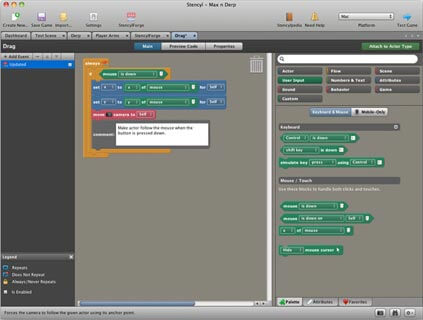


There is a subtle bug in our example code above.
#Stencyl behaviors full#
Like this.įor reference, the full list of key codes can be looked up here. It is best practice to compare the "key code" of the event with the "key code of " block, rather than hardcoding the number directly. This block returns a unique number for each keyboard key. To check if these keys have been pressed, use the key code block instead. Special keys such as ENTER and BACKSPACE do not map to characters.

#Stencyl behaviors how to#
This example shows how to use the keyboard to implement a 4-way motion behavior. Other mobile input topics are covered separately. Read our Touch article for further details and examples on both single touch, multi touch and gestures. To keep things simple for you, mouse input is equivalent to single-touch input. To show or hide the cursor, use this block.Įxercise: How would you create a custom cursor? One method is to hide the cursor and create a dummy actor that continually follows the mouse but does not collide with anything. Sometimes, you want to hide the cursor or display a custom cursor. Mouse presses and releases involving an actor can also be detected using the On Actor event (under Add Event > Input) Mouse Cursor Over Actor is our term for hovering the mouse over the actor. Similarly, mouse input over an actor involves 4 different states. You can also grab the (x,y) location of the mouse on screen or any recent presses/releases. Mouse presses and releases can also be detected using the Click event (under Add Event > Input) Mouse Position Pressed and Released are one-off “events” - they fire once per that action, whereas “down” is a constant state that can be checked. Mouse Input is detected through 3 different states. Note: To reduce the amount of setup, all Stencyl games come pre-shipped with a default set of controls (arrow keys, action 1, action 2).

With Controls, you just change what key the Control is mapped to. What if you wanted to make your control scheme configurable? That would be a mess.What if you decide to change your control scheme? You’d have to change it everywhere. Why can’t we just check the key directly? Now, when you check whether a key is pressed, released or down, instead of checking directly on a certain key (such as spacebar), you check the state of the Control. From there, you tell us the name of the Control and the button it maps to. Next, click the Controls button to view the Controls pane. To set Controls, click the Settings button, shown below, to open that dialog. The same idea applies to Stencyl, through a game’s Controls Page. For example, if we were designing a control scheme for a Mario game, it would look like this. We use the notion of a an Control to make your keyboard controls flexible and easy to remap.Ī Control is a name that you assign to an action in a game. Looking for our article on Gamepads (External Controllers)? Contentsĭetecting keyboard input works differently in Stencyl than it does in other systems.


 0 kommentar(er)
0 kommentar(er)
